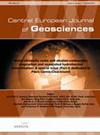Eruptive history of the Barombi Mbo Maar, Cameroon Volcanic Line, Central Africa: Constraints from volcanic facies analysis
引用次数: 24
Abstract
Abstracthis study presents the first and detail field investigations of exposed deposits at proximal sections of the Barombi Mbo Maar (BMM), NE Mt Cameroon, with the aim of documenting its past activity, providing insight on the stratigraphic distribution, depositional process, and evolution of the eruptive sequences during its formation. Field evidence reveals that the BMM deposit is about 126m thick, of which about 20m is buried lowermost under the lake level and covered by vegetation. Based on variation in pyroclastic facies within the deposit, it can be divided into three main stratigraphic units: U1, U2 and U3. Interpretation of these features indicates that U1 consists of alternating lapilli-ash-lapilli beds series, in which fallout derived individual lapilli-rich beds are demarcated by surges deposits made up of thin, fine-grained and consolidated ash-beds that are well-defined, well-sorted and laterally continuous in outcrop scale. U2, a pyroclastic fall-derived unit, shows crudely lenticular stratified scoriaceous layers, in which many fluidal and spindle bombs-rich lapilli-beds are separated by very thin, coarse-vesiculatedash-beds, overlain by a mantle xenolith- and accidental lithic-rich explosive breccia, and massive lapilli tuff and lapillistone. U3 displays a series of surges and pyroclastic fall layers. Emplacement processes were largely controlled by fallout deposition and turbulent diluted pyroclastic density currents under “dry” and “wet” conditions. The eruptive activity evolved in a series of initial phreatic eruptions, which gradually became phreatomagmatic, followed by a phreato-Strombolian and a violent phreatomagmatic fragmentation. A relatively long-time break, demonstrated by a paleosol between U2 and U3, would have permitted the feeding of the root zone or the prominent crater by the water that sustained the next eruptive episode, dominated by subsequent phreatomagmatic eruptions. These preliminary results require complementary studies, such as geochemistry, for a better understanding of the changes in the eruptive styles, and to develop more constraints on the maar’s polygenetic origin.中非喀麦隆火山线Barombi Mbo Maar的喷发历史:来自火山相分析的约束
摘要本文对喀麦隆山东北部Barombi Mbo Maar (BMM)近段暴露矿床进行了首次详细的野外调查,目的是记录其过去的活动,提供地层分布、沉积过程和形成期间喷发序列演化的见解。野外资料显示,BMM矿床厚度约为126m,其中约20m埋于湖底以下,被植被覆盖。根据矿床内火山碎屑岩相的变化,将其划分为U1、U2和U3三个主要地层单元。对这些特征的解释表明,U1由交替的金银石-灰泥-金银石层系列组成,其中由沉降物衍生的个别金银石层由薄细粒固结灰泥层组成的涌积矿床划分,这些涌积层在露头尺度上定义明确,分选良好,横向连续。火山碎屑落源单元U2为粗透镜状层状碎屑岩层,其中许多流体状和纺锤状的金银石层被非常薄的粗泡状灰岩层隔开,上覆地幔包体和偶然的富岩爆角砾岩、块状金银石凝灰岩和金银石石。U3呈现一系列的涌浪和火山碎屑跌落层。在“干”和“湿”条件下,安置过程主要受沉降物沉积和湍流稀释火山碎屑密度流的控制。喷发活动演变为一系列最初的潜水喷发,逐渐演变为潜水岩浆,随后是潜水-斯特龙堡期和剧烈的潜水岩浆碎裂。U2和U3之间的古土壤证明了一个相对较长的断裂,这将允许根区或突出的火山口被水滋养,这些水维持了下一次喷发,主要是随后的呼吸岩浆喷发。这些初步结果需要补充研究,如地球化学,以更好地了解喷发方式的变化,并对maar的多成因起源进行更多的限制。
本文章由计算机程序翻译,如有差异,请以英文原文为准。
求助全文
约1分钟内获得全文
求助全文
来源期刊

Central European Journal of Geosciences
GEOSCIENCES, MULTIDISCIPLINARY-
自引率
0.00%
发文量
0
审稿时长
>12 weeks
 求助内容:
求助内容: 应助结果提醒方式:
应助结果提醒方式:


